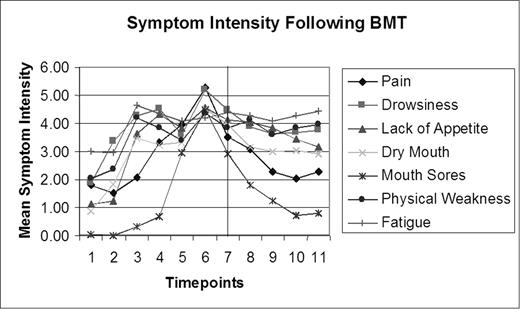Abstract
Symptom burden (SB) is the combined impact of all disease- or therapy-related symptoms on one’s ability to function as one did before onset of disease or therapy. Clinician report of BMT toxicities is well described, but patient report of symptoms is not. Lack of understanding of symptoms and SB may result in failure to address symptoms and return patients to optimum functioning. The purpose of this study was to describe symptoms and SB in AML/MDS patients undergoing allogeneic BMT before and after neutrophil engraftment (first of 3 consecutive days ANC ≥ 500 cells/mm3). Methods: 30 patients with a mean age of 52.9 yrs (SD 9.6) rated 19 symptoms on a 0-10 scale twice weekly from baseline before the start of conditioning to 28 days post-BMT using the M. D. Anderson Symptom Inventory. Results: Patient/treatment characteristics are summarized in Table 1.
Patient/Treatment Characteristics
| . | n . | % . |
|---|---|---|
| Sex | ||
| Male | 17 | 56.7 |
| Female | 13 | 43.3 |
| Conditioning | ||
| Myeloablative | 17 | 56.7 |
| Non-myeloablative | 13 | 43.3 |
| Donor | ||
| Related | 13 | 43.3 |
| Unrelated | 17 | 56.7 |
| Cell Source | ||
| BM | 13 | 43.3 |
| PBSCs | 17 | 56.7 |
| . | n . | % . |
|---|---|---|
| Sex | ||
| Male | 17 | 56.7 |
| Female | 13 | 43.3 |
| Conditioning | ||
| Myeloablative | 17 | 56.7 |
| Non-myeloablative | 13 | 43.3 |
| Donor | ||
| Related | 13 | 43.3 |
| Unrelated | 17 | 56.7 |
| Cell Source | ||
| BM | 13 | 43.3 |
| PBSCs | 17 | 56.7 |
Mean global symptom intensity (GSI) peaked at Day +11 post-BMT. The 7 most severe symptoms on Day +11 were pain, drowsiness, lack of appetite, dry mouth, mouth sores, physical weakness, and fatigue. Mean symptom intensity scores and SDs are reported in Table 2.
Mean Symptom Intensity Scores
| Symptom . | Baseline . | Day +11 . | Day +15 . | Day +29 . |
|---|---|---|---|---|
| . | Mean, SD . | Mean, SD . | Mean, SD . | Mean, SD . |
| GSI | 1.32, 1.38 | 3.08, 1.74 | 2.72, 1.91 | 2.24, 1.59 |
| Pain | 1.80, 2.91 | 5.30, 2.68 | 3.52, 2.84 | 2.29, 2.45 |
| Drowsiness | 1.87, 2.50 | 5.20, 2.89 | 4.48, 3.00 | 3.75, 3.08 |
| Lack of Appetite | 1.10, 2.22 | 4.57, 3.18 | 4.14, 3.32 | 3.18, 2.88 |
| Dry Mouth | 0.87, 1.61 | 4.52, 3.21 | 3.97, 3.52 | 2.93, 3.21 |
| Mouth Sores | 0.03, 0.18 | 4.50, 3.95 | 2.93, 3.21 | 0.82, 2.06 |
| Physical Weakness | 2.03, 2.55 | 4.37, 2.86 | 3.83, 2.90 | 3.96, 2.76 |
| Fatigue | 3.00, 2.29 | 4.20, 2.57 | 4.41, 2.78 | 4.46, 2.82 |
| Symptom . | Baseline . | Day +11 . | Day +15 . | Day +29 . |
|---|---|---|---|---|
| . | Mean, SD . | Mean, SD . | Mean, SD . | Mean, SD . |
| GSI | 1.32, 1.38 | 3.08, 1.74 | 2.72, 1.91 | 2.24, 1.59 |
| Pain | 1.80, 2.91 | 5.30, 2.68 | 3.52, 2.84 | 2.29, 2.45 |
| Drowsiness | 1.87, 2.50 | 5.20, 2.89 | 4.48, 3.00 | 3.75, 3.08 |
| Lack of Appetite | 1.10, 2.22 | 4.57, 3.18 | 4.14, 3.32 | 3.18, 2.88 |
| Dry Mouth | 0.87, 1.61 | 4.52, 3.21 | 3.97, 3.52 | 2.93, 3.21 |
| Mouth Sores | 0.03, 0.18 | 4.50, 3.95 | 2.93, 3.21 | 0.82, 2.06 |
| Physical Weakness | 2.03, 2.55 | 4.37, 2.86 | 3.83, 2.90 | 3.96, 2.76 |
| Fatigue | 3.00, 2.29 | 4.20, 2.57 | 4.41, 2.78 | 4.46, 2.82 |
There was a significant difference (t=−4.34, p<.001) between the mean GSI at baseline and Day +11. Neutrophil engraftment occurred on average 13.7 days (SD=3.00) post-BMT. There was no significant difference (t=0.75, p=.455) in mean GSI from Day +11 to Day + 15, the first post-engraftment assessment. Mean GSI declined by Day +29, but the difference between the mean GSI on Day +11 and Day +29 was not significant (t=1.92, p=.060). At Day +15, only mean pain intensity had declined significantly (t=2.48, p=.016) from Day +11. At Day +29, mean pain and mouth sores intensity had declined significantly (t=4.46, p<.001 and t=2.26, p=.031, respectively) from Day+11. Conclusion: Patients report various symptoms post-allogeneic BMT, with the most intense involving the upper GI tract, pain, fatigue, and weakness. After engraftment, pain intensity declines rapidly, GI symptoms decline more slowly, and fatigue and weakness do not decline.
Most symptoms have not declined significantly a month post-BMT and patients remain burdened by symptoms. Clinicians should verify with patients the symptoms they are experiencing and intervene to control them. Further research is needed in SB and causative mechanisms of symptoms after BMT to improve treatment outcomes.
Author notes
Corresponding author


